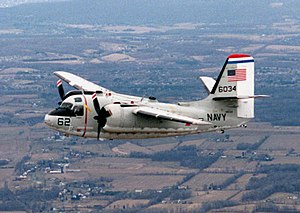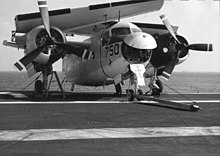| C-1 (TF) Trader | |
|---|---|
 A C-1A Trader from Naval Air Station, Willow Grove, Pennsylvania in 1987 A C-1A Trader from Naval Air Station, Willow Grove, Pennsylvania in 1987 | |
| General information | |
| Type | Carrier onboard delivery |
| National origin | United States |
| Manufacturer | Grumman |
| Primary user | United States Navy |
| Number built | 87 |
| History | |
| Introduction date | 1956 |
| First flight | 19 January 1955 |
| Retired | 1988 |
| Developed from | Grumman S-2 Tracker |
| Developed into | Grumman E-1 Tracer |
The Grumman C-1 Trader (TF prior to 1962) is a carrier onboard delivery (COD) variant of the Grumman S-2 Tracker. It was replaced by a similar version of the Northrop Grumman E-2 Hawkeye, the Grumman C-2 Greyhound.
Design and development
The C-1 Trader grew out of a need by the United States Navy for a new anti-submarine airplane. In response to this Grumman began development on a prototype twin-engine, high-wing aircraft which it designated the G-89. In 1952 the Navy designated this aircraft the XS2F-1 and flew it for the first time on December 4 that year. During the rest of the 1950s three major variants emerged, the C-1 Trader being one of them. The C-1 (originally the TF-1, for "Trainer", a secondary role) was outfitted to carry nine passengers or 3,500 pounds (1,600 kg) of cargo and first flew in January 1955.
Operational history
Throughout the 1960s and 1970s the C-1 Trader carried mail and supplies to aircraft carriers on station in the Pacific Ocean during the Vietnam War and also served as a trainer for all-weather carrier operations. Over its production life 87 C-1 Traders were built, of which four were converted into EC-1A Tracer electronic countermeasures aircraft. The last C-1 was retired from USN service in 1988; it was the second-to-last radial-engine aircraft in U.S. military service (The last C-131 wasn't retired until 1990). As of 2010, approximately ten were still airworthy in civil hands, operating as warbirds.
In 1956 the U.S. Marine Corps Test Unit Number 1 (MCTU #1) tested the concept of using the TF-1 variant as a vehicle for inserting reconnaissance teams behind enemy lines. “On 9 July 1956 MCTU Recon Marines became the first to parachute from a TF-1. Less than three weeks later, four recon parachutists launched from the USS Bennington, which was 70 miles at sea, and jumped on a desert drop zone near El Centro California, some 100 miles inland. For the first time in Marine Corps and Naval Aviation history, the technique of introducing recon personnel off a carrier sea base to an inland objective had successfully been tested.”
In August 2010, Brazilian Naval Aviation announced that it would buy and modernize eight C-1 airframes to serve in carrier onboard delivery (COD) and aerial refueling roles for use on its aircraft carrier São Paulo. In 2011 contract was signed with Marsh Aviation to convert four ex-US Navy C-1A Trader airframes into KC-2 Turbo Traders. The first KC-2 prototype flight was expected for November 2017 and the delivery of the first operational aircraft was scheduled for December 2018; in 2014 the contract was reaffirmed, but by 2023, with no aircraft having been delivered and São Paulo long since having been stricken, the contract was cancelled.
Variants


- TF-1
- Carrier Onboard Delivery version of the S-2 Tracker with enlarged fuselage for nine passengers, redesignated C-1A in 1962, 87 built.
- TF-1Q
- Electronic Countermeasures conversion of the TF-1, redesignated EC-1A in 1962, four conversions.
- TF-1W
- Airborne Early Warning project that was developed in the WF-2 Tracer.
- C-1A
- TF-1 redesignated in 1962.
- EC-1A
- TF-1Q redesignated in 1962.
- KC-2 Turbo Trader
- Marsh Aviation modernization project for Air-to-Air Refueling, requested for the Brazilian Navy.
- G-101
- proposed 10-12 seat passenger variant
- G-104
- proposed tanker variant
Operators
 Brazil (Retired)
Brazil (Retired)
Surviving aircraft
- Airworthy
- BuNo 136752 – based at Lauridsen Aviation Museum in Buckeye, Arizona.
- BuNo 136766 – privately owned in Carson City, Nevada.
- BuNo 136773 – privately owned in Wilmington, Delaware.
- BuNo 136778 – based at Champaign Aviation Museum in Urbana, Ohio.
- BuNo 136781 – based at Pacific Coast Air Museum in Santa Rosa, California.
- BuNo 146027 – privately owned in Wilmington, Delaware.
- BuNo 146044 – privately owned in Oklahoma City, OK.
- BuNo 146048 – privately owned in Reno, Nevada.
- BuNo 146052 – based at Lone Star Flight Museum in Galveston, Texas.
- On display
- BuNo 136754 – National Museum of Naval Aviation, NAS Pensacola, Pensacola, Florida.
- BuNo 136790 – Grissom Air Museum, Grissom ARB (former Grissom AFB), Kokomo, Indiana.
- BuNo 136792 – NAVSUP Weapon Systems Support Philadelphia, Pennsylvania. (formerly display at the Quonset Air Museum)
- BuNo 146034 – Wings of Freedom Aviation Museum, former NAS Willow Grove, Horsham, Pennsylvania.
- BuNo 146036 – USS Midway Museum, San Diego, California.
Specifications (C-1A)
Data from Grumman aircraft since 1929.
General characteristics
- Crew: 3
- Capacity: 9 pax / 8,500 lb (3,856 kg) payload
- Length: 42 ft (13 m)
- Wingspan: 69 ft 8 in (21.23 m)
- Height: 16 ft 3.5 in (4.97 m)
- Wing area: 485 sq ft (45.1 m)
- Airfoil: root: NACA 63A420; tip: NACA 63A415
- Empty weight: 16,631 lb (7,544 kg)
- Gross weight: 23,031 lb (10,447 kg)
- Max takeoff weight: 24,600 lb (11,158 kg)
- Powerplant: 2 × Wright R-1820-82WA Cyclone 9-cylinder air-cooled radial piston engines, 1,525 hp (1,137 kW) each
- Propellers: 3-bladed constant-speed fully-feathering reversible-pitch propellers
Performance
- Maximum speed: 280 mph (450 km/h, 240 kn) at 4,000 ft (1,200 m)
- Cruise speed: 167 mph (269 km/h, 145 kn)
- Range: 1,110 mi (1,790 km, 960 nmi)
- Service ceiling: 24,800 ft (7,600 m)
- Rate of climb: 1,950 ft/min (10 m/s)
- Wing loading: 47.5 lb/sq ft (232 kg/m)
- Power/mass: 0.13 hp/lb (0.21 kW/kg)
See also
Related development
Aircraft of comparable role, configuration, and era
References
- Bishop, Chris; Chant, Chris (2004). Aircraft Carriers. London: Summertime Publishing Ltd. p. 168. ISBN 0-7603-2005-5.
- Donald, David; Daniel J. March (2001). Carrier Aviation Air Power Directory. Norwalk, CT: AIRtime Publishing. ISBN 1-880588-43-9.
- Lanning and Stubbe, Michael, Ray (1989). Inside Force Recon. Ivy Books. p. 34. ISBN -08041-0301-1.
{{cite book}}: CS1 maint: multiple names: authors list (link) - "Brazilian navy buys Traders".
- ^ "Brazilian Navy restarts KC-2 Turbo Trader contract". FlightGlobal.
- "Brazilian Navy kills KC-2 project 12 years later and without receiving any aircraft". The Rio Times. 29 March 2023. Retrieved 14 November 2024.
- "Brazilian Traders set for modernisation" Fight Global, 14 Dec 2011 Retrieved: 23 December 2011
- "Grumman C-1 Trader/136752." Lauridsen Aviation Museum. Retrieved: 6 August 2021.
- "FAA Registry/N71456." faa.gov Retrieved: 6 August 2021.
- "FAA Registry/N6193Z." faa.gov Retrieved: 6 August 2021.
- "FAA Registry/N6193N." faa.gov Retrieved: 6 August 2021.
- "Grumman C-1 Trader/136778." Champaign Aviation Museum. Retrieved: 6 August 2021.
- "FAA Registry/N778SR." faa.gov Retrieved: 6 August 2021.
- "Grumman C-1A Trader/136781." Pacific Coast Air Museum. Retrieved: 6 August 2021.
- "FAA Registry/N475AM." faa.gov Retrieved: 6 August 2021.
- "FAA Registry/N927BN." faa.gov Retrieved: 6 August 2021.
- "FAA Registry/N189G." faa.gov Retrieved: 3 January 2023.
- "FAA Registry/N7171M." faa.gov Retrieved: 6 August 2021.
- "FAA Registry/N81193." faa.gov Retrieved: 6 August 2021.
- "Grumman C-1A Trader/136754." National Naval Aviation Museum. Retrieved: 27 April 2016.
- "Grumman C-1A Trader/136790." Grissom Air Museum. Retrieved: 27 April 2016.
- "USA Museum or Outside Display TF-1 /C-1A Traders". Grumman S2F Tracker Survivors. Retrieved 3 August 2023.
- "Grumman C-1A Trader/146034." Wings of Freedom Museum. Retrieved: 27 April 2016.
- "Grumman C-1A Trader/146036." USS Midway Museum. Retrieved: 27 April 2016.
- Francillon, René Jacquet (1989). Grumman aircraft since 1929 (1st ed.). London: Putnam. pp. 387–393. ISBN 0851778356.
- Lednicer, David. "The Incomplete Guide to Airfoil Usage". m-selig.ae.illinois.edu. Retrieved 16 April 2019.
External links
[REDACTED] Media related to Grumman C-1 Trader at Wikimedia Commons
| United States military transport aircraft designations, Army/Air Force and Tri-Service systems | |
|---|---|
| Army/Air Force sequence (1925–1962) |
|
| Tri-service sequence (1962–present) | |
| Revived original sequence (2005–present) | |
| Non-sequential designations | |
| Related designations | |
| Not assigned • Assigned to multiple types • Unconfirmed | |
| USN/USMC trainer aircraft designations pre–1962 | |||||||||||||||||||||||||||||||||||
|---|---|---|---|---|---|---|---|---|---|---|---|---|---|---|---|---|---|---|---|---|---|---|---|---|---|---|---|---|---|---|---|---|---|---|---|
| N-series (1922–1948) |
| ||||||||||||||||||||||||||||||||||
| T-series (1948–1962) |
| ||||||||||||||||||||||||||||||||||
| |||||||||||||||||||||||||||||||||||